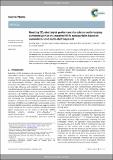Boosting CO2 electrolysis performance : via calcium-oxide-looping combined with in situ exsolved Ni-Fe nanoparticles in a symmetrical solid oxide electrolysis cell
Abstract
The electrocatalysis of CO2 to valuable chemical products is an important strategy to combat global warming. Symmetrical solid oxide electrolysis cells have been extensively recognized for their CO2 electrolysis abilities due to their high efficiency, low cost, and reliability. Here, we produced a novel electrode containing calcium oxide-looping and in situ exsolved Ni–Fe nanoparticles by performing a one-step reduction of La0.6Ca0.4Fe0.8Ni0.2O3−δ (LCaFN). The CO2 captured by CaO was electrolyzed in situ by the Ni–Fe nanocatalysts. The cell with this special cathode showed a higher current density (0.632 A cm−2vs. 0.32 A cm−2) and lower polarization resistance (0.399 Ω cm2vs. 0.662 Ω cm2) than the unreduced LCaFN cathode at 800 °C with an applied voltage of 1.3 V. Use of the developed novel electrode offers a promising strategy for CO2 electrolysis.
Citation
Tian , Y , Liu , Y , Naden , A , Jia , L , Xu , M , Cui , W , Chi , B , Pu , J , Irvine , J T S & Li , J 2020 , ' Boosting CO 2 electrolysis performance : via calcium-oxide-looping combined with in situ exsolved Ni-Fe nanoparticles in a symmetrical solid oxide electrolysis cell ' , Journal of Materials Chemistry A , vol. 8 , no. 30 , pp. 14895-14899 . https://doi.org/10.1039/d0ta05518b
Publication
Journal of Materials Chemistry A
Status
Peer reviewed
ISSN
2050-7488Type
Journal article
Description
Financial support from National Key Research & Development Project (2016YFE0126900), National Natural Science Foundation of China (51672095), Hubei Province (2018AAA057) and the EPSRC Capital for Great Technologies Grant EP/L017008/1. We are grateful to the China Scholarship Council for funding (201806160178).Collections
Items in the St Andrews Research Repository are protected by copyright, with all rights reserved, unless otherwise indicated.

